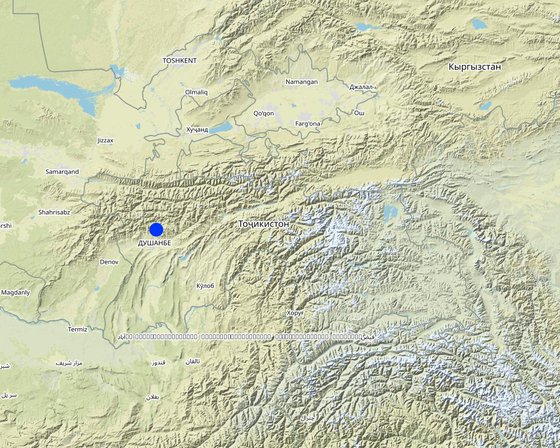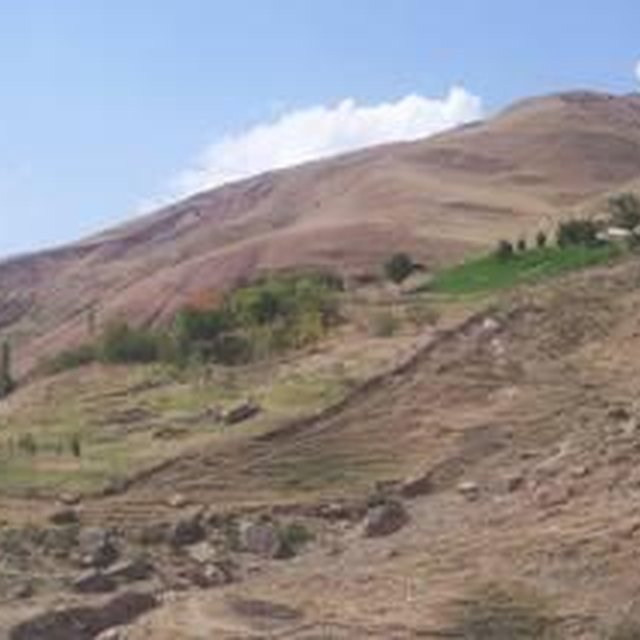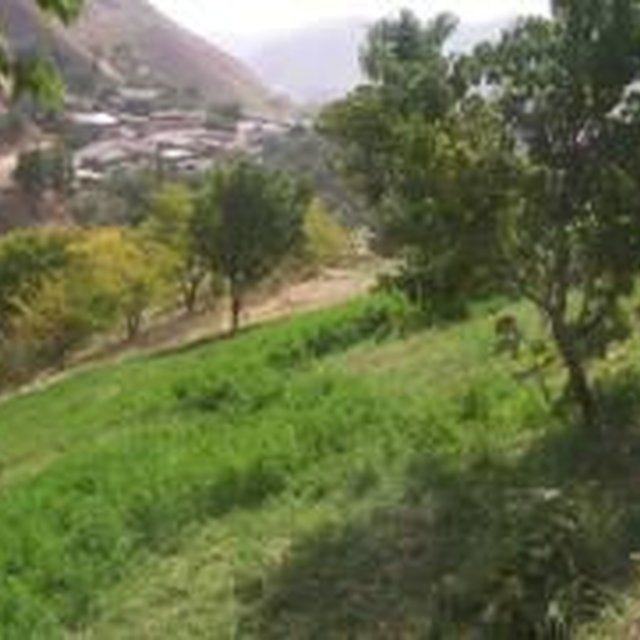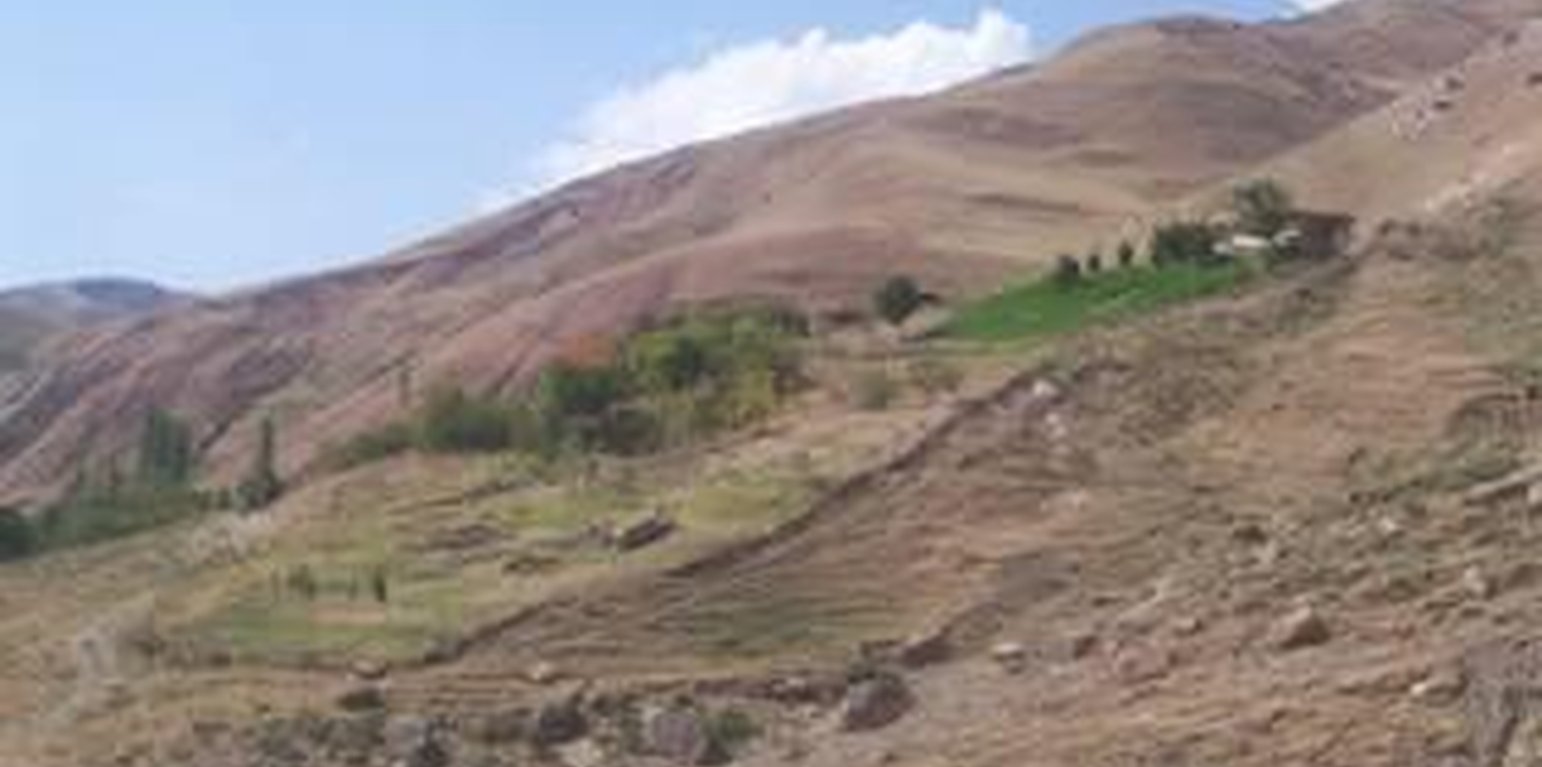Enhancement of existing SLM technologies into demonstration sites
(Tayikistán)
ADB, GEF, GITEC, DMC. Rural Development Project
Descripción
Enhancement of existing self developed SLM technologies into demonstration sites.
Aims / objectives: The farmer clearly stated that his prime, initial aim in taking over this “ruined and abandoned land” was to improve and better assure the quality of his family’s lifestyle, through enhanced and assured food and fodder production. He also recognised the potential for future profit, through sale of his excess produce to market. Currently, the family has almost no need to buy food (and fodder) from nearby markets, apart from flour (for bread making). This is a large cost saving factor. In hindsight, the farmer sees that he has dramatically improved land quality within the enclosure through mitigating erosion and increasing year-round vegetation cover
Methods: The success of the enclosure is the result of using several methods. The fence construction was critical to keep out both domestic animals (cattle, goats and sheep) and wild ones, (pigs and wolves) from what was to become a vegetation rich “island” amoungst the bare and degraded hillslopes. Stone clearing (by hand) of the whole area inside the enclosure greatly improved land quality due to enhanced soil depth and subsequent vegetative growth. Tree planting (apple, cherry, apricot, pear) was critical to provide family food. Lucerne planting provided food for the farmer’s animals (1 cow, 10 goats) that provide milk and meat. A small area of land near the homestead (approx. 20 x 20 metres) was levelled into several small terraces for vegetable production (potatoes, garlic, onion, peppers, tomatoes). Irrigation is conducted within the upper part of the enclosure; water being provided by a 20mm polythene pipe that brings water from 1.5 km away where there is a permanent spring.
Stages of implementation: The family (Enomali) first occupied this land in 1984. The first task was tree planting – the first orchard trees – on 0.1 ha of the current enclosure. This was fenced, then after nine family members left (to work in Dushanbe) he expanded the fence to the current 0.2 ha and continued to plant trees. Stone removal continued through the 1990s and even to today. The lucerne and vegetable gardens were initiated in the 1990s and continue to be enriched. The fodder, trees and vegetable production is an ongoing task, as is feeding the animals with the home-grown fodder. He continues to plant orchard trees every year and currently has more than 100. He gained a “certificate” of ownership” in 2008.
Role of stakeholders: All of the work within the enclosure has been conducted by family members. The main two are the husband and wife, though in the early stone clearing and fence construction days his 1st cousin assisted. His son and daughter in law have also assisted (though the son now works in Dushanbe) – even the young grandchildren help.
Lugar

Lugar: Varzob, Luchob, RRP, Tayikistán
Georreferencia de sitios seleccionados
Dato de inicio: 1984
Año de conclusión: 2014
Tipo de Enfoque
-
tradicional/ local
-
iniciativa local reciente/ innovadora
-
proyecto/ basado en un programa
-
Local initiative enhanced by programme activity

photo shows the enclosure with homestead at top, lucerne (bright green) on upper slope, fruit trees (mid slope) and stone piles on stone-cleared land at slope bottom. Very evident is the strong contra (Des McGarry (Land Management Institute, Giprozem 15, Dushanbe, ))

View from inside the enclosure, showing lucerne (fodder), orchard trees and a vegetable garden (right hand edge). (Des McGarry (Land Management Institute, Giprozem 15, Dushanbe, ))
Metas del Enfoque y entorno facilitador
Propósitos/ objetivos principales del Enfoque
The Approach focused on SLM only
The prime, initial aim in taking over this “ruined and abandoned land” was to improve and better assure the quality of his family’s lifestyle through enhanced and assured food and fodder production. He also recognised the potential for future profit, through sale of his excess produce to market. Now, he wants to expand the area within the enclosure to 1 ha with extra fencing and supplementary irrigation supply from another spring.
The SLM Approach addressed the following problems: The main problem to be addressed was reducing poverty, to help achieve a better and more sustainable lifestyle by producing better quality food and fodder.
Condiciones que facilitan la implementación de la/s Tecnología/s aplicadas bajo el Enfoque
-
Marco de trabajo legal (tenencia de tierra, derechos de uso de tierra y agua): The existing land ownership, land use rights / water rights helped a little the approach implementation: There was no compelling need for the farmer to get a “entitlement certificate” but he did so anyway.
Condiciones que impiden la implementación de la/s Tecnología/s aplicadas bajo el Enfoque
-
Normas y valores sociales/ culturales/ religiosos: This family were one of the first in this region to take over this area of “ruined” land and begin improvements. However, the farmer did not see this as arduous, rather he welcomed the chance to work hard and provide for his family
Treatment through the SLM Approach: Family working together to improve land
-
Disponibilidad/ acceso a recursos y servicios financieros : The farmer could improve his SLM but would need financial assistance
Treatment through the SLM Approach:
-
Entorno institucional: He has now gained a certificate of ownership that ensures ownership until his death. The government still owns the land and he pays $5 US a year in tax (total).
Treatment through the SLM Approach: Application for land entitlement certificate
-
Marco de trabajo legal (tenencia de tierra, derechos de uso de tierra y agua): Not applicable. The water (irrigation) is “free” and there are no current disputes over his use of the spring water
Treatment through the SLM Approach:
-
Conocimiento de MST, acceso a apoyo técnico: The family provided their own solutions to any problems since the project began in 1984
Treatment through the SLM Approach:
-
Carga de trabajo, disponibilidad de mano de obra: The family have worked consistently for 26 years, slowly but have created better land and vegetation conditions
Treatment through the SLM Approach:
Participación y roles de las partes interesadas involucradas
Partes interesadas involucradas en el Enfoque y sus roles
| ¿Qué partes interesadas/ entidades implementadoras estuvieron involucradas en el Enfoque? |
Especifique las partes interesadas |
Describa los roles de las partes interesadas |
| usuarios locales de tierras/ comunidades locales |
Only the land users (family) |
The men focused on the heavier labour tasks of fence building and stone removal. The women focus on the garden, and fruit production and bee keeping. |
Involucramiento de los usuarios locales de tierras/ comunidades locales en las distintas fases del Enfoque
ninguno
pasivo
apoyo externo
interactivo
auto-movilización
iniciación/ motivación
The extended family, when available
planificación
Principally the husband and wife – Mr Enomali and wife
monitoreo y evaluación
Mr Enomali and his wife are continuously evaluating the production quantities and quality from their labours
La toma de decisiones en la selección de Tecnología MST
Las decisiones fueron tomadas por
-
solamente usuarios de tierras (autoiniciativa)
-
principalmente usuarios de tierras con el apoyo de especialistas MST
-
todos los actores relevantes, como parte de un enfoque participativo
-
principalmente por especialistas MST en consulta con usuarios de tierras
-
solo por especialistas MST
-
por políticos/ líderes
La toma de decisiones se basa en
-
la evaluación de conocimiento MST bien documentado (la toma de decisiones se basa en evidencia)
-
hallazgos de investigaciones
-
la experiencia personal y opiniones (no documentadas)
Apoyo técnico, fortalecimiento institucional y gestión del conocimiento
Las siguientes actividades o servicios fueron parte del enfoque
-
Construcción de capacidades / capacitación
-
Servicio de asesoría
-
Fortalecimiento institucional (desarrollo institucional)
-
Monitoreo y evaluación
-
Investigación
Monitoreo y evaluación
bio-physical aspects were ad hoc monitored by land users through observations; indicators: The family, generally, take note of the effect of their practices in terms of production
economic / production aspects were None monitored by None through observations; indicators: None
There were no changes in the Approach as a result of monitoring and evaluation: None
There were no changes in the Technology as a result of monitoring and evaluation: None
Financiamiento y apoyo material externo
Presupuesto anual en dólares americanos para el componente MST
-
< 2,000
-
2,000-10,000
-
10,000-100,000
-
100,000-1,000,000
-
> 1,000,000
Precise annual budget: n.d.
Approach costs were met by the following donors: local community / land user(s) (The Emomali family): 100.0%
Los siguientes servicios o incentivos fueron proporcionados a los usuarios de las tierras
-
Apoyo financiero/material proporcionado a los usuarios de tierras
-
Subsidios para insumos específicos
-
Crédito
-
Otros incentivos o instrumentos
Análisis de impacto y comentarios de conclusión
Impactos del Enfoque
No
Sí, un poco
Sí, moderadamente
Sí, mucho
¿El Enfoque ayudó a los usuarios de tierras a implementar y mantener Tecnologías MST?
There is a dramatic visible difference in both the degree of erosion and vegetative land cover between the enclosure and the surrounding land (see picture in 1.3.3). Also, the production quantity and quality of food and fodder from this enclosure has continued to increase.
¿El Enfoque empoderó a grupos en desventaja social y económica?
After the fall of the Soviet Union, many in Tajikistan experienced poverty, particularly food shortages. This farmer foresaw this and commenced his enclosure enrichment work. In this way he ensured
Did other land users / projects adopt the Approach?
The farmer says that several of his neighbours have been doing similar interventions to his – fencing, stone removal, planting orchards etc. What he has done is very visible from the main road through the valley, and many people have observed the results of his efforts over the years
Motivación principal del usuario de la tierra para implementar MST
-
producción incrementada
-
incremento de la renta(bilidad), proporción mejorada de costo-beneficio
-
reducción de la degradación de la tierra
-
reducción del riesgo de desastres naturales
-
carga de trabajo reducida
-
pagos/ subsidios
-
reglas y reglamentos (multas)/ aplicación
-
prestigio, presión social/ cohesión social
-
afiliación al movimiento/ proyecto/ grupo/ redes
-
conciencia medioambiental
-
costumbres y creencias, moral
-
conocimiento y capacidades mejorados de MST
-
mejoramiento estético
-
mitigación de conflicto
-
well-being and livelihoods improvement
Sostenibilidad de las actividades del Enfoque
¿Pueden los usuarios de tierras sostener lo que se implementó mediante el Enfoque (sin apoyo externo)?
The farmer never had external “support” in the first place, so his approach continues to improve, with no support.
Conclusiones y lecciones aprendidas
Fortalezas: perspectiva del usuario de tierras
-
As above, as these words were transcribed during the farmer interview, on site
Fortalezas: punto de vista del compilador o de otra persona recurso clave
-
Though not an initial objective, the farmer now recognises that he has dramatically improved land quality and vegetation cover within the enclosure, further assuring continued increased production through improved soil conditions (How to sustain/ enhance this strength: By continuing to do what he has been doing for 20+ years already. )
-
The farmer has achieved what he wanted; assured quantity and quality of food/fodder production to assure his family’s livelihood. (How to sustain/ enhance this strength: He wants to increase his enclosure area by 5 times. To do this he will require fencing and pipe for irrigation.)
Debilidades/ desventajas/ riesgos: perspectiva del usuario de tierrascómo sobreponerse
-
As above, as these were the sentiments of the farmer during on site interview
Debilidades/ desventajas/ riesgos: punto de vista del compilador o de otra persona recurso clavecómo sobreponerse
-
The farmer does not have sufficient financial means to purchase the additional fencing and irrigation pipe he requires to extend the current enclosure area to 1 ha size
Involvement of local banks
-
The total lack of institutional support. This has not necessarily negatively impacted on the farmer – but rather has led to a reduced uptake of his (excellent) practices elsewhere, both locally and nationally.
Immediate visits of local agronomic staff (governmental) to record the modalities of what has been achieved at this site, to help ensure the wider implementation for improved land quality and vegetative cover, at a more national level.
Referencias
Revisado por
-
David Streiff
-
Alexandra Gavilano
-
Joana Eichenberger
Fecha de la implementación: 4 de mayo de 2011
Últimas actualización: 2 de noviembre de 2021
Personas de referencia
-
Habib Kamolidinov (habib1982@mail.ru) - Especialista MST
-
Des McGarry (mcgarrd@nrm.qld.gov.au) - Especialista MST
Descripción completa en la base de datos de WOCAT
La documentación fue facilitada por
Institución
- GITEC/ADB/DMC Rural Development Project Land Management Institute - Tayikistán
Proyecto
- Pilot Program for Climate Resilience, Tajikistan (WB / PPCR)
Referencias claves
-
There is no relevant documentation:






